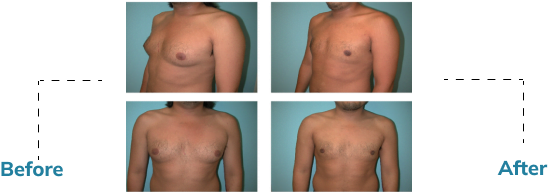Gynecomastia - Male Breast Liposuction

Gynecomastia is enlarged breasts in men. It can be treated effectively by surgery. Pseudo Gynecomastia is chest fat. The main difference between Gynecomastia and Chest Fat is the mass that causes the swelling.
Gynecomastia commonly occurs in three age groups – Infants, Pubertal (Adolescent) &Elderly
Causes
Many factors have been attributed.
- The most accepted theory is that the enlargement is due to an increased level of oestrogen in the body. This may be due to lowered testosterone effect or peripheral conversion of testosterone to oestrogen.
- The anabolic steroids which the body builders take can lead to Gynecomastia.
- Few medical conditions and drugs may cause male breast enlargement.
- Regardless of the cause, this condition causes social embarrassment. Many report that they forego swimming and playing to avoid taking their shirts off.
- However, it may trigger some serious psychological effects, as most men and boys do not want a feminine look.
- Seventy percent of boys of adolescent age experience breast development as they go through puberty.
- There is no increased risk for cancer.
- Diet and exercise may help to reduce fat content but the fibrous glandular component and skin excess could only be corrected surgically to restore a normal appearance.
Treatment
Surgery is the standard treatment for Gynecomastia. “Lipoplasty” has been accepted as the standard procedure in correcting Gynecomastia with good result. Lipoplasty includes a combination of Liposuction with excision of remaining fibrous glandular tissue. The procedure is performed under General Anaesthesia and patient is discharged home the same evening. Liposuction alone could be performed with two key holes on either side while excision requires a semi-circular incision at the junction of Areola with the skin.
Complications
- Bleeding
- Bruising and numbness lasting for three to four weeks.
- Hardness within the tissues due to swelling can persist for a month or longer.
- Patient could return to work in a week’s time and resume the normal daily activities except driving.
- Pain on lifting heavy weight and vigorous exercise could be experienced up to two months.
- Avoid swimming and sports for at least a month. Less strenuous exercise, such as walking, is recommended.
Result

